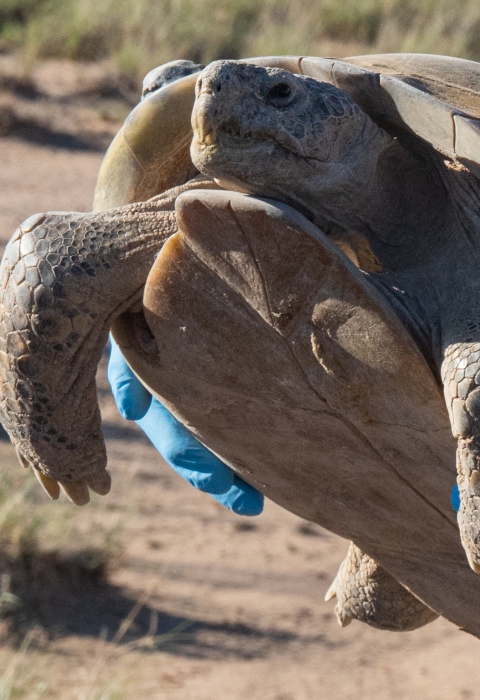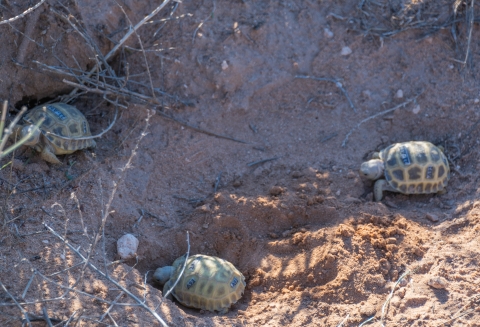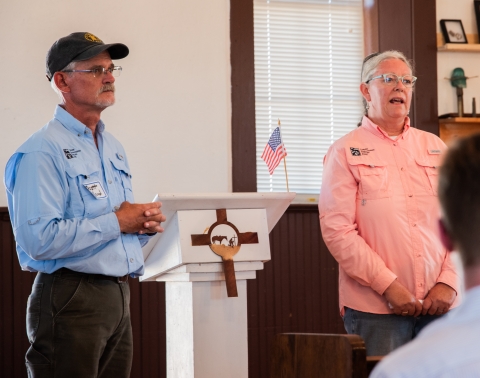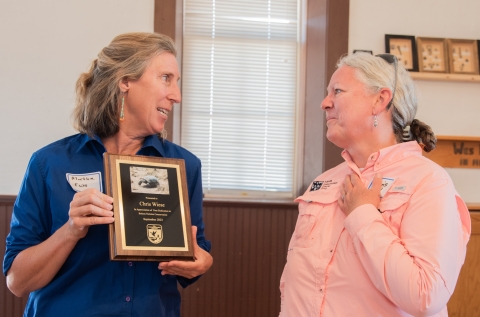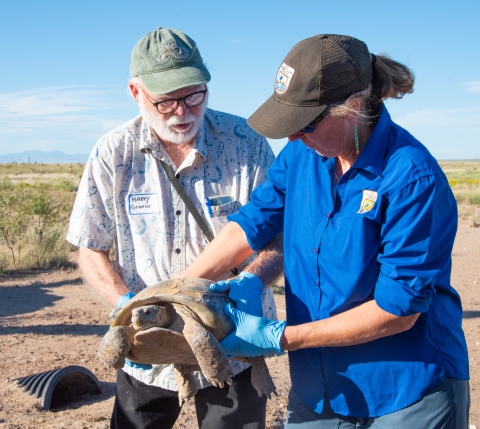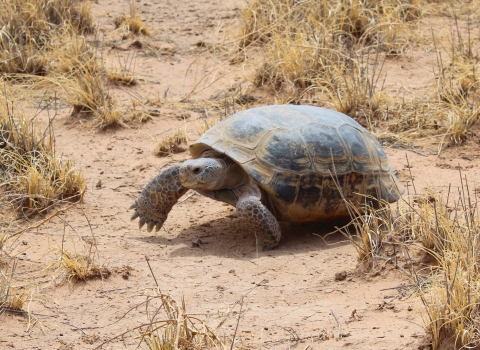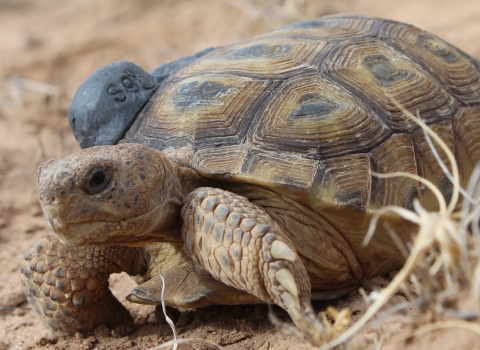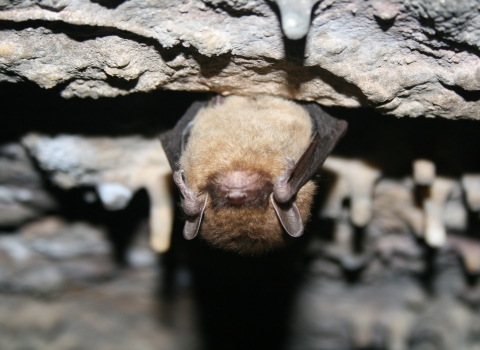This is Part Two of a series. Read Part One
Part One Recap: In the 1950s in Mexico, scientists first described a new species of North American tortoise. In the 1970s Several of these Bolson tortoises we brought to the Appleton-Whittell Research Ranch including the first, a large female tortoise named Gertie, whose age is unknow, but experts estimate she’s at least in her 80s, and is still in prime breeding age.
In 2004, Ariel Appleton, who was the caretaker of the Research Ranch’s Bolson tortoises, died. Her estate donated those tortoises to Ted Turner’s biodiversity NGO Turner Endangered Species Fund (TESF) facilities in southern New Mexico. There, married couple/biologists Scott Hillard and Dr. Chris Wiese have worked since 2007 raising a Bolson tortoise recovery population for reintroduction to the American Southwest.
“Our goal is to establish self-sustaining, minimally managed, free-living populations on the Turner ranches,” explained Hillard. “Allowing them to thrive where the animal and its ecosystem aren't under constant threat.” Through Hillard, Dr. Wiese, and TESF’s dedication, their Bolson tortoise conservation project has grown the Appleton group of 30 tortoises to over 800.
Currently, the wild population in Mexico is around 2,500 individuals and shrinking. While Mexico’s Bolson de Mapimi Biosphere Reserve is protected along with the tortoise, declines persist. In their burrows Bolson tortoises can sense movement and will move to the entrance to guard their home. Adult tortoises have been observed crushing coyotes. However, they’re ill-equipped for human interactions, so it’s key that new wild populations are in remote areas inaccessible to the public.
A crucial component of Bolson recovery is the blessing of federal wildlife policy. Officially, Bolsons have been considered a foreign endangered species. Can the Endangered Species Act of 1973 be used to recover a species that was extirpated from the U.S. thousands of years ago?
"This was a good species for us to ask those questions and have those philosophical discussions,” explained Wiese. “That came to a head on September 22, 2023, with the announcement that the U.S. Fish and Wildlife Service is now interested in recovering the species here.”
On that date, the Turner organization and the U.S. Fish and Wildlife Service became official partners in the recovery of the Bolson tortoise in the U.S. via a Safe Harbor Agreement. The signing was celebrated at an event where Service Director Martha Williams recognized TESF Executive Director Mike Phillips, Hillard, and Dr. Wiese for their work toward this goal, along with the Living Desert Zoo and Gardens State Park, the Turtle Conservancy, and the Desert Tortoise Council among others for their contributions of resources to Bolson tortoise recovery.
The event also signified that, for the first time in thousands of years, Bolson tortoises could roam freely in the U.S., unencumbered by fences, open to the elements and the threat of natural predators, to breed and make their own life.
“There’s so much about Bolson tortoise that we still don’t know,” said Service Director Martha Williams “They live and grow at such a pace that we need to think generationally for their recovery, but that’s how we should be thinking.”
Looking Ahead
“With this agreement, the New Mexico Ecological Services Field Office is taking responsibility for recovery of this species,” said Shawn Sartorius, the office’s supervisor. “Previously the Bolson tortoises was under the purview of our International Affairs Program.”
Dr. Morafka, Ariel Appleton, various zoos and NGOs, and the Turner organization are owed a tremendous amount of credit for creating a new home in the U.S. for the Bolson tortoise. However, private individuals and organizations are limited in the scope of what they can accomplish. A lifetime of work can be measured in raising a single generation of hatchlings to adulthood. Meanwhile, Gertie is likely older than 80 and is still laying eggs. What will become of her progeny?
“This Safe Harbor Agreement was one of my first assignments,” said Vance Wolf, a U.S. Fish and Wildlife Service herpetologist who came on in 2021. “The next step is developing a recovery plan, establishing a secure captive breeding program, and identifying potential release sites. We’re looking at remote places to avoid human-caused mortality from collection and vehicle collisions.”
Gertie doesn’t seem to mind where she lives, so long as she has a burrow, which is where Bolsons spend 95 percent of their time. Their tendency to move toward their burrow’s entrance has unfortunately been their downfall, because that exposes them to collection by people. It’s the hope of conservationists that a new home in the U.S. can reverse their current downward trend. With perseverance, and the continued cooperation from a multitude of partners, Gertie stands as a symbol for the plight of her species, and her offspring represent hope for their future.
From Dr. Morafka and Mexican conservationists, to Ariel Appleton and Dr. Jarchow at the Research Ranch, to Hillard and Dr. Wiese with TESF, and a network of herpetologists and NGOs who have devoted so much to this recovery: the stewardship of Gertie and her progeny, and the recovery of their species can’t be realized in any one lifetime.
Over Dr. Wiese and Hillard’s 15 years in tortoise time, they are at the cusp of seeing TESF’s first hatchlings come into breeding age.
In an interview with the Associated Press, Dr. Wiese said, “We are not in the business of making pets, we’re in the business of making wild animals, and that means you have to let them go.”
ESA@50 – 2023 marks the 50th Anniversary of the Endangered Species Act of 1973. Recovery of species like the Bolson tortoise is complex and difficult work, often requiring substantial time and resources. Species today face ongoing threats like habitat loss as well as new threats like climate change climate change
Climate change includes both global warming driven by human-induced emissions of greenhouse gases and the resulting large-scale shifts in weather patterns. Though there have been previous periods of climatic change, since the mid-20th century humans have had an unprecedented impact on Earth's climate system and caused change on a global scale.
Learn more about climate change and wildlife trafficking. We have a continued commitment as a nation to protect imperiled species.
Today, hundreds of species are stable or improving thanks to management actions of tribes, federal agencies, state and local governments, conservation organizations and private citizens. Our partners share a commitment to build on our accomplishments and expand innovative initiatives to further this mission in the future.
